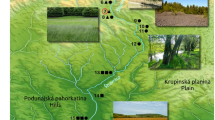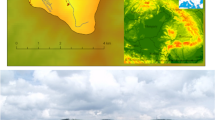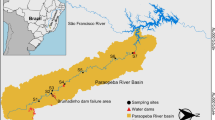Abstract
Recently, speculation has grown that the European forest damage may be caused by the continual exposure of trees to rainwater containing trialkyl lead salts1 (R3PbX; R = ethyl, methyl). These are degradation products of tetraalkyl lead (R4Pb) which are added to petroleum as anti-knock agents; they inhibit tubulin polymerization2,3 and are highly toxic to mammalian and plant cells4. Here we describe the analysis of rainwater samples collected at two sites in the Black Forest, FRG. Total lead content was measured by atomic absorption and found to be in the range previously determined for rural areas5. The portion of R3PbX was assayed by the inhibition of pork brain tubulin polymerization. R3PbX was present in one-third of all rainwater samples. The highest concentration was 0.3 µM, that is 103 times higher than previously reported5. For comparison, 1 µM R3PbX killed soybean cells or neuroblastoma cells in culture4.
This is a preview of subscription content, access via your institution
Access options
Subscribe to this journal
Receive 51 print issues and online access
$199.00 per year
only $3.90 per issue
Buy this article
- Purchase on Springer Link
- Instant access to full article PDF
Prices may be subject to local taxes which are calculated during checkout
Similar content being viewed by others
References
Faulstich, H. & Stournaras, C. Naturw. Rdsch. Stuttgart 10, 398–401 (1984).
Zimmermann, H.-F., Roederer, G. & Doenges, K. H. J. Submicrosc. Cytol. 16, 203–205 (1984).
Faulstich, H., Stournaras, C., Doenges, K. H. & Zimmermann, H.-P. FEBS Lett. 174, 128–131 (1984).
Stournaras, C., Zimmermann, H.-P., Doenges, K. H. & Faulstich, H. Cell Biochem. Funct. 2, 213–216 (1984).
De Jonghe, W. R. A., van Mol, W. E. & Adams, F. Proc. int. Conf. Heavy Metals in the Environment, Heidelberg, 166–168 (CEP Consultants, Edinburgh, 1983).
Harrison, R. M. & Perry, R. Atmos. Envir. 11, 847–852 (1977).
De Jonghe, W. R. A. & Adams, F. C. Talenta 29, 1057–1067 (1982).
De Jonghe, W. R. A., Chakraborti, D. & Adams, F. C. Envir. Sci. Technol. 15, 1217–1222 (1981).
Edwards, H. W. & Rosenvold, R. J. in Trace Contaminants in the Environment, Proc. 2nd A. NSF-RANN Trace Contam. Conf. 59–64 (NSF-RANN, California, 1974).
Harrison, R. M. J. Envir. Sci. Hlth A11, 417–423 (1976).
Jensen, K. A. in Biological Effects of Organolead Compounds (eds Grandjean, P. & Grandjean, E. C.), 1–4 (CRC, Boca Raton, 1984).
Potter, H. R., Jarvie, A. W. P. & Markall, R. N. Wat. Pollut. Contr. 76, 123–128 (1977).
De Jonghe, W. R. A., Van Mol, W. E. & Adams, F. C. Analyt. Chem. 55, 1050–1054 (1983).
Roederer, G. in Biological Effects of Organolead Compounds (eds Grandjean, P. & Grandjean, E. C.) 63–95 (CRC, Boca Raton, 1984).
Ahlberg, J., Ramel, C. & Wachtmeister, C. A. Ambio 1, 29–31 (1972).
Ramel, C. Mutat. Res. 21, 45–46 (1973).
Author information
Authors and Affiliations
Rights and permissions
About this article
Cite this article
Faulstich, H., Stournaras, C. Potentially toxic concentrations of triethyl lead in Black Forest rainwater samples. Nature 317, 714–715 (1985). https://doi.org/10.1038/317714a0
Received:
Accepted:
Issue Date:
DOI: https://doi.org/10.1038/317714a0
This article is cited by
-
Effects of heavy metals on pollen tube growth and ultrastructure
Protoplasma (1995)
-
Different effects of inorganic and triethyl lead on growth and ultrastructure of lily pollen tubes
Protoplasma (1988)
-
Trialkyllead. Occurrence, biological interactions, and possible impact on forest decline
Experientia (1987)
-
Interpretation of element analyses of spruce-needle tissue falsified by atmospheric surface deposition
Naturwissenschaften (1987)
-
Trialkyl lead in rain in the Black Forest
Nature (1986)
Comments
By submitting a comment you agree to abide by our Terms and Community Guidelines. If you find something abusive or that does not comply with our terms or guidelines please flag it as inappropriate.



